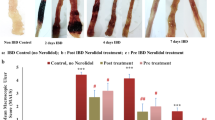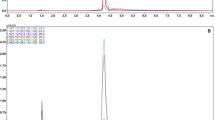Abstract
Traditional ayurvedic medicine, Arjunarishta (AA) is used to treat several inflammatory conditions including dysentery associated with blood. The formulation is a decoction of Terminalia arjuna (Roxb.) Wight and Arn. (TA), Madhuca indica J.F.Gmel., Vitis vinifera L., Woodfordia fruticosa (L.) Kurz., and Saccharum officinarum L. Terminalia arjuna, a major constituent of this formulation has been recognized for anti-inflammatory effects. This study aimed at evaluating beneficial effects of AA and probable mechanism of action in Trinitrobenzenesulphonicacid (TNBS) induced colitis model. Response to AA treatment was explored through determination of disease activity index (DAI), histological assessment and damage scores, colonic pro-inflammatory cytokine/chemokine expression and estimation of oxidative stress biomarkers. Improvement in gut microbiome and plasma zinc level was also assessed. Study findings directed therapeutic effects of AA treatment in colitis model by attenuating the colitis symptoms such as weight loss, diarrhoea, blood in stool; histological damage; and downregulated expression of pro-inflammatory cytokines/chemokine (TNF-α, IL-1β, IL-6) and MCP-1). Similarly reduced oxidative stress by decreased level of Nitric Oxide (NO), Myeloperoxidase (MPO), Malondialdehyde (MDA) and enhanced level of Catalase (CAT), Superoxide dismutase (SOD) and Reduced Glutathione (GSH) was also witnessed. In addition, an improved beneficial fecal microbiome profile and restored plasma zinc status was revealed compared to the TNBS control group. The present study directs that downregulated pro-inflammatory cytokines/chemokine expression, enhancement of antioxidant effect, increased plasma zinc status and promising role in modulating fecal microbiome might be potential mechanisms for the therapeutic effect of AA treatment against colitis.
Graphic abstract






Similar content being viewed by others
Abbreviations
- AA:
-
Arjunarishta
- CAT:
-
Catalase
- DAI:
-
Disease activity index
- GSH:
-
Glutathione
- IBD:
-
Inflammatory bowel disease
- IL-6:
-
Interleukin-6
- IL-1β:
-
Interleukin-1β
- MCP-1:
-
Monocyte chemotactic protein
- MDA:
-
Malondialdehyde
- MPO:
-
Myeloperoxidase
- NO:
-
Nitric oxide
- SOD:
-
Superoxide dismutase
- TNF-α:
-
Tumour necrosis factor-α
- TNBS:
-
Trinitrobenzenesulfonic acid
- UC:
-
Ulcerative colitis
References
Ordás I, Eckmann L, Talamini M, Baumgart DC, Sandborn WJ (2012) Ulcerative colitis. Lancet 380:1606–1619
Bouma G, Strober W (2003) The immunological and genetic basis of inflammatory bowel disease. Nat Rev Immunol 3:521–533
Krela-Kaźmierczak I, Michalak M, Wawrzyniak A et al (2017) The c.29T > C polymorphism of the transforming growth factor beta-1 (TGFB1) gene, bone mineral density and the occurrence of low-energy fractures in patients with inflammatory bowel disease. Mol Biol Rep 44:455–461
Mahadevan U (2004) Medical treatment of ulcerative colitis. Clin Colon Rectal Surg 17:7–19
Li J, Zhou R, He W et al (2011) Effects of recombinant human intestinal trefoil factor on trinitrobenzene sulphonic acid induced colitis in rats. Mol Biol Rep 38:4787–4792
Ke F, Yadav PK, Ju LZ (2012) Herbal medicine in the treatment of ulcerative colitis. Saudi J Gastroenterol 18:3–10
Valero MS, González M, Ramón-Gimenez M et al (2019) Jasonia glutinosa (L.) DC., a traditional herbal medicine, reduces inflammation, oxidative stress and protects the intestinal barrier in a murine model of colitis. Inflammopharmacol doi. https://doi.org/10.1007/s10787-019-00626-0. [Epub ahead of print]
Mishra S (2005) Bhaisazya Kalpana Vigyan. Chaukambha Bharati Prakashan, Varanasi, pp 277–280
Sadhanandham S, Narayanan G, Rao MRK, Prabhu K, Jones S, Ravi A (2015) GC-MS analysis and antioxidant studies of an ayurvedic drug, Partharishtam. Int J Pharm Sci Rev Res 34:273–281
Kapoor D, Vijayvergiya R, Dhawan V (2014) Terminalia arjuna in coronary artery disease: ethnopharmacology, pre-clinical, clinical and safety evaluation. J Ethnopharmacol 155:1029–1045
Gairola S, Sharma J, Gaur RD, Siddiqi TO, Painuli RN (2013) Plants used for treatment of dysentery and diarrhoea by the Bhoxa community of district Dehradun, Uttarakhand, India. J Ethnopharmacol 150:989–1006
Cota D, Mishra S, Shengule S (2019) Beneficial role of Terminalia arjuna hydro-alcoholic extract in colitis and its possible mechanism. J Ethnopharmacol 30:117–125
Lal UR, Tripathi SM, Jachak SM, Bhutani KK, Singh IP (2009) HPLC analysis and standardisation of arjunarishta—an ayurvedic cardioprotective formulation. Sci Pharm 77:605–616
Cota D, Mishra S, Shengule SA, Patil D (2020) Assessment of in vitro biological activities of Terminalia arjuna Roxb. bark extract and Arjunarishta in inflammatory bowel disease and colorectal cancer. Indian J Exp Biol 58:306–313
Shengule S, Kumbhare K, Patil D, Mishra S, Apte K, Patwardhan B (2018) Herb-drug interaction of Nisha Amalaki and Curcuminoids with metformin in normal and diabetic condition: a disease system approach. Biomed Pharmacother 101:591–598
Morris GP, Bekh PL, Herridge MS, Depew WT, Szewczuk MR, Wallace JL (1989) Hapten-induced model of chronic inflammation and ulceration in the colon rat. Gastroenterology 96:795–803
Shengule SA, Mishra S, Joshi K, Apte K, Patil D, Kale P (2018) Anti-hyperglycemic and anti-hyperlipidaemic effect of Arjunarishta in high-fat fed animals. J Ayurveda Inter Med 9:45–52
Dong WG, Liu SP, Yu BP, Wu DF, Luo HS, Yu JP (2003) Ameliorative effects of sodium ferulate on experimental colitis and their mechanisms in rats. World J Gastroenterol 9:2533–2538
Kim JJ, Shajib MS, Manocha MM, Khan WI (2012) Investigating intestinal inflammation in DSS-induced model of IBD. J Vis Exp 60:3678
Uchiyama M, Mihara M (1978) Determination of malonaldehyde precursor in tissues by thiobarbituric acid test. Anal Biochem 86:271–278
Goth L (1991) A simple method for determination of serum catalase activity and revision of reference range. Clin Chim Acta 196:143–152
Marklund S, Marklund G (1974) Involvement of the superoxide anion radical in the autooxidation of pyrogallol and a convenient assay for superoxide dismutase. Eur J Biochem 47:469–474
Rahman I, Kode A, Biswas SK (2006) Assay for quantitative determination of glutathione and glutathione disulfide levels using enzymatic recycling method. Nat Protoc 1:3159–3165
Green LC, Wagner DA, Glogowski J, Skipper PL, Wishnok JS, Tannenbaum SR (1982) Analysis of nitrate, nitrite, and [15N] nitrate in biological fluids. Anal Biochem 126:131–138
Jaiswal S, Mishra S, Torgal SS, Shengule S (2018) Neuroprotective effect of epalrestat mediated through oxidative stress markers, cytokines and TAU protein levels in diabetic rats. Life Sci 207:364–371
Daddaoua A, Martı ´nez-Plata E, Lo ´pez-Posadas R, Marı ´a Vieites J, Gonza ´lez M, Requena P et al (2007) Active hexose correlated compound acts as a prebiotic and is antiinflammatory in rats with hapten-induced colitis. J Nutr 137:1222–1228
Singh UP, Singh NP, Busbee B, Guan H, Singh B, Price RL (2012) Alternative medicines as emerging therapies for inflammatory bowel diseases. Int Rev Immunol 31:66–84
Kondamudi PK, Malayandi R, Eaga C, Aggarwal D (2013) Drugs as causative agents and therapeutic agents in inflammatory bowel disease. Acta Pharm Sin B 3:289–296
Guo BJ, Bian ZX, Qiu HC, Wang YT, Wang Y (2017) Biological and clinical implications of herbal medicine and nature products for the treatment of inflammatory bowel disease. Ann NY Acad Sci 1401:37–48
Antoniou E, Margonis GA, Angelou A, Pikouli A, Argiri P, Karavokyros I (2016) The TNBS-induced colitis animal model: an overview. Ann Med Surg 11:9–15
Szalai Z, Szasz A, Nagy I, Puskas LG, Kupai K, Kiraly A et al (2014) Anti-inflammatory effect of recreational exercise in TNBS-induced colitis in rats: role of NOS/HO/MPO system. Oxid Med Cell Longev 2014:925981
Rana SV, Sharma S, Prasad KK, Sinha SK, Singh K (2013) Role of oxidative stress and antioxidant defence in ulcerative colitis patients from north India. Indian J Med Res 139:568–571
Li Z, Ma T, Zhang W, Shang Y, Zhang Y, Ma Y (2020) Genipin attenuates dextran sulfate sodium induced colitis via suppressing infammatory and oxidative responses. Inflammopharmacol 28:333–339
Medhi B, Prakasha A, Avti K, Saikia UN, Pandhia P, Khanduja KL (2008) Effect of manuka honey and sulfasalazine in combination to promote antioxidant defence system in experimentally induced ulcerative colitis model in rats. Indian J Exp Biol 46:583–590
Tsunada S, Iwakiri R, Ootani H, Aw TY, Fujimoto K (2003) Redox imbalance in the colonic mucosa of ulcerative colitis. Scand J Gastroenterol 38:1002–1003
Suzuki Y, Matsumoto T, Okamoto S, Hibi T (2008) A lecithinized superoxide dismutase (PC-SOD) improves ulcerative colitis. Colorectal Dis 10:931–934
Bhattacharyya A, Chattopadhyay R, Mitra S, Crowe SE (2014) Oxidative stress: an essential factor in the pathogenesis of gastrointestinal mucosal diseases. Physiol Rev 94:329–354
Liu X, Wang J (2011) Anti-inflammatory effects of iridoid glycosides fraction of Folium syringae leaves on TNBS-induced colitis in rats. J Ethnopharmacol 133:780–787
Fan H, Gao Z, Ji K, Li X, Wu J, Liu Y et al (2019) The in vitro and in vivo anti-inflammatory effect of osthole, the major natural coumarin from Cnidium monnieri (L.) Cuss, via the blocking of the activation of the NF-κB and MAPK/p38 pathways. Phytomedicine 58:152864
Sanchez-Muñoz F, Dominguez-Lopez A, Yamamoto-Furusho JK (2008) Role of cytokines in inflammatory bowel disease. World J Gastroenterol 14:4280–4288
Rogler G, Andus T (1998) Cytokines in inflammatory bowel disease. World J Surg 22:382–389
Bribi N, Algieri F, Rodríguez-Nogales A, Vezza T, Garrido-Mesa J, Utrilla MP, Contreras MD, Maiza F, Segura-Carretero A, Rodríguez-Cabezas ME, Gálvez J (2016) Intestinal anti-inflammatory effects of total alkaloid extract from Fumaria capreolata in the DNBS model of mice colitis and intestinal epithelial CMT93 cells. Phytomedicine 23:901–913
Reimund JM, Wittersheim C, Dumont S, Muller CD, Baumann R, Poindron P, Duclos B (1996) Mucosal inflammatory cytokine production by intestinal biopsies in patients with ulcerative colitis and Crohn’s disease. J Clin immunol 16:144–150
Soares NRM, de Moura MSB, de Pinho FA, Silva TMC, Barros SdL, Amorim AdC et al (2018) Effects of zinc supplementation on inflammatory response and gene expression of Zn metalloproteins in patients with ulcerative colitis. PharmaNutrition 6(3):119–124
Ananthakrishnan AN, Higuchi LM, Khalili H, Richter JM, Song M, Chan AT (2015) Zinc intake and risk of Crohn’s disease and ulcerative colitis: a prospective cohort study. Int J Epidemiol 44:1995–2005
van O’Callaghan A (2016) Bifidobacteria and their role as members of the human gut microbiota. Front Microbiol 7:925
Tojo R, Suárez A, Clemente MG, de los Reyes-Gavilán CG, Margolles A et al (2014) Intestinal microbiota in health and disease: role of bifidobacteria in gut homeostasis. World J Gastroenterol 20:15163–15176
Madsen KL, Doyle JS, Jewell LD, Tavernini MM, Fedorak RN (1999) Lactobacillus species prevents colitis in interleukin 10 gene–deficient mice. Gastroenterology 116:1107–1114
Fukuda Y, Tao Y, Tomita T, Hori K, Fukunaga K, Noguchi T et al (2006) A traditional Japanese medicine mitigates TNBS-induced colitis in rats. Scand J Gastroenterol 41:1183–1189
Traina G, Proietti PC, Menchetti L, Leonardi L, Tomasello G, Barbatoet O et al (2016) Colon microbial composition is correlated with the severity of colitis induced by 2,4,6-trinitrobenzenesulfonic acid in mice. Euro Mediterr Biomed J 11:165–175
Funding
The study was not funded by the institution.
Author information
Authors and Affiliations
Corresponding author
Ethics declarations
Conflict of interest
The authors have no conflict of interest.
Additional information
Publisher's Note
Springer Nature remains neutral with regard to jurisdictional claims in published maps and institutional affiliations.
Electronic supplementary material
Below is the link to the electronic supplementary material.
Rights and permissions
About this article
Cite this article
Cota, D., Mishra, S. & Shengule, S. Arjunarishta alleviates experimental colitis via suppressing proinflammatory cytokine expression, modulating gut microbiota and enhancing antioxidant effect. Mol Biol Rep 47, 7049–7059 (2020). https://doi.org/10.1007/s11033-020-05766-z
Received:
Accepted:
Published:
Issue Date:
DOI: https://doi.org/10.1007/s11033-020-05766-z




